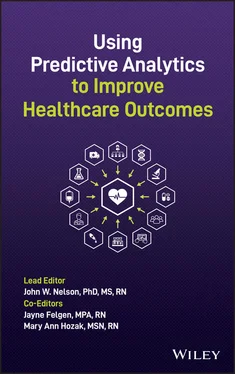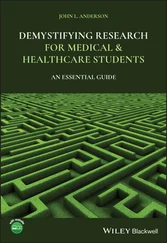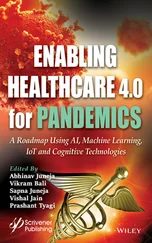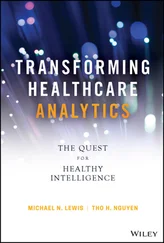Using Predictive Analytics to Improve Healthcare Outcomes
Здесь есть возможность читать онлайн «Using Predictive Analytics to Improve Healthcare Outcomes» — ознакомительный отрывок электронной книги совершенно бесплатно, а после прочтения отрывка купить полную версию. В некоторых случаях можно слушать аудио, скачать через торрент в формате fb2 и присутствует краткое содержание. Жанр: unrecognised, на английском языке. Описание произведения, (предисловие) а так же отзывы посетителей доступны на портале библиотеки ЛибКат.
- Название:Using Predictive Analytics to Improve Healthcare Outcomes
- Автор:
- Жанр:
- Год:неизвестен
- ISBN:нет данных
- Рейтинг книги:5 / 5. Голосов: 1
-
Избранное:Добавить в избранное
- Отзывы:
-
Ваша оценка:
- 100
- 1
- 2
- 3
- 4
- 5
Using Predictive Analytics to Improve Healthcare Outcomes: краткое содержание, описание и аннотация
Предлагаем к чтению аннотацию, описание, краткое содержание или предисловие (зависит от того, что написал сам автор книги «Using Predictive Analytics to Improve Healthcare Outcomes»). Если вы не нашли необходимую информацию о книге — напишите в комментариях, мы постараемся отыскать её.
Discover a comprehensive overview, from established leaders in the field, of how to use predictive analytics and other analytic methods for healthcare quality improvement. Using Predictive Analytics to Improve Healthcare Outcomes
before
proven in advance
Using Predictive Analytics to Improve Healthcare Outcomes
Using Predictive Analytics to Improve Healthcare Outcomes — читать онлайн ознакомительный отрывок
Ниже представлен текст книги, разбитый по страницам. Система сохранения места последней прочитанной страницы, позволяет с удобством читать онлайн бесплатно книгу «Using Predictive Analytics to Improve Healthcare Outcomes», без необходимости каждый раз заново искать на чём Вы остановились. Поставьте закладку, и сможете в любой момент перейти на страницу, на которой закончили чтение.
Интервал:
Закладка:
Table of Contents
1 Cover
2 Title Page
3 Copyright Page
4 Dedication Page
5 Contributors
6 Foreword
7 Preface: Bringing the Science of Winning to Healthcare
8 List of Acronyms
9 Acknowledgments
10 Section One: Data, Theory, Operations, and Leadership 1 Using Predictive Analytics to Move from Reactive to Proactive Management of Outcomes The Art and Science of Making Data Accessible Summary 1: The “Why” Summary 2: The Even Bigger “Why” Implications for the Future 2 Advancing a New Paradigm of Caring Theory Maturation of a Discipline Theory Frameworks of Care RBC's Four Decades of Wisdom Summary 3 Cultivating a Better Data Process for More Relevant Operational Insight Taking on the Challenge “PSI RNs”: A Significant Structural Change to Support Performance and Safety Improvement Initiatives and Gain More Operational Insight The Importance of Interdisciplinary Collaboration in Data Analysis Key Success Factors Summary 4 Leadership for Improved Healthcare Outcomes Data as a Tool to Make the Invisible Visible Leaders Using Data for Inspiration: Story 1 Leaders Using Data for Inspiration: Story 2 How Leaders Can Advance the Use of Predictive Analytics and Machine Learning Understanding an Organization's “Personality” Through Data Analysis
11 Section Two: Analytics in Action 5 Using Predictive Analytics to Reduce Patient Falls Predictors of Falls, Specified in Model 1 Lessons Learned from This Study Respecifying the Model Summary 6 Using the Profile of Caring® to Improve Safety Outcomes The Profile of Caring Machine Learning Exploration of Two Variables of Interest: Early Readmission for Heart Failure and Falls Proposal for a Machine Learning Problem Constructing the Study for Our Machine Learning Problem 7 Forecasting Patient Experience: Enhanced Insight Beyond HCAHPS Scores Methods to Measure the Patient Experience Results of the First Factor Analysis Implications of This Factor Analysis Predictors of Patient Experience Discussion Transforming Data into Action Plans Summary 8 Analyzing a Hospital‐Based Palliative Care Program to Reduce Length of Stay Building a Program for Palliative Care Demographics of the Patient Population for Model 1 Results from Model 1 Respecifying the Model Discussion 9 Determining Profiles of Risk to Reduce Early Readmissions Due to Heart Failure Step 1: Seek Established Guidelines in the Literature Step 2: Crosswalk Literature with Organization's Tool Step 3: Develop a Structural Model of the 184 Identified Variables Step 4: Collect Data Details of the Study Limitations of the Study Results: Predictors of Readmission in Fewer Than 30 Days Next Steps 10 Measuring What Matters in a Multi‐Institutional Healthcare System Testing a Model of Caring Methods Results from the Study of Model 1 Respecifying the Model Testing Model 2 Results from the Study of Model 2 The Self‐Care Factor Further Discussion Summary 11 Pause and Flow: Types of Pause Types of Flow Methods Sample Size and Response Rates What We Learned About Pause What We Learned About Flow Application of Results to Operations Reflections from the Medical Unit—R6S Analyzing Pause and Flow of Work as a Method of Quality Improvement Summary and Next Steps 12 Lessons Learned While Pursuing CLABSI Reduction Development of a Specified Model of Measurement for Prevention of CLABSI First Lesson Learned: Quality Data Collection Requires Well‐Trained Data Collectors Other Lessons Learned Summary and Next Steps
12 Section Three: Refining Theories to Improve Measurement 13 Theory and Model Development to Address Pain Relief by Improving Comfort A New Theory Developing a New Model Based on a New Theory Clinicians' Beliefs Drive Their Practice Dimensions of Comfort Predictors of Comfort The Model Summary 14 Theory and Model Development to Improve Recovery from Opioid Use Disorder The Current Costs of Opioid Use Disorder (OUD) Interventions for OUD Pain Management, OUD, and Therapeutic Relationships Interventions Which Include Potential Trusted Others Existing OUD Measurement Instruments Updating the Old OUD Measurement Instrument and Model to Include the Trusted Other Discussion Conclusion
13 Section Four: International Models to Study Constructs Globally 15 Launching an International Trajectory of Research in Nurse Job Satisfaction, Starting in Jamaica Background The Hunch: Where Measurement Begins The Model Understanding the Context of Jamaica Methods to Study Job Satisfaction and Clarity in Jamaica Managing Disappointment with the Low Response Rate Results on the Social and Technical Dimensions of Nurse Job Satisfaction in Jamaica Results on the Relationship of Role Clarity and Demographics to Nurse Job Satisfaction in Jamaica Application of the Findings 16 Testing an International Model of Nurse Job Satisfaction to Support the Quadruple Aim The Four Goals of Our Study Methods Theoretical Framework Measurement Instruments and a Model of Measurement Order of Operations of the Study Simplifying the Model Respecifying the Model to Include Caring Results from Model 2 How Job Satisfaction Relates to Turnover and Sick Time Recommendations Based on Findings 17 Developing a Customized Instrument to Measure Caring and Quality in Western Scotland Developing an Instrument to Measure Caring as Perceived by the Patient Developing an Instrument to Measure Caring as Perceived by the Nursing Staff Building a Structural Model for Assessing How Caring, Clarity, and Job Satisfaction Relate to One Another in Western Scotland Results Testing the Final Model to Measure the Experience of Nurses Discussion 18 Measuring the Effectiveness of a Care Delivery Model in Western Scotland The Caring Behaviors Assurance System (CBAS) Implementation of CBAS Measurement of CBAS Findings from the PCQI, the Operations of CBAS Assessment, and the HES Action Planning Discussion
14 Epilogue: Imagining What Is Possible
15 Appendix A: Worksheets Showing the Progression from a Full List of Predictor Variables to a Measurement Model
16 Appendix B: The Key to Making Your Relationship-Based Care® Implementation Sustainable Is “I 2E 2”
17 Appendix D: Calculation for Cost of Falls
18 Appendix D: Possible Clinical, Administrative, and Psychosocial Predictors of Readmission for Heart Failure in Fewer Than 30 Days After Discharge
19 Appendix E: Process to Determine Variables for Lee, Jin, Piao, & Lee, 2016 Study
20 Appendix F: Summary of National and International Heart Failure GuidelinesNational Institute for Health and Care Excellence (NICE) Guidelines
21 Appendix G: Crosswalk Hospital Tool and Guidelines
22 Appendix H: Comprehensive Model of 184 Variables Found in Guidelines and Hospital Tool
23 Appendix I: Summary of Variables That Proved Insignificant After Analysis
24 Appendix J: Summary of Inconclusive Findings
25 Appendix K: Nine Tools for Measuring the Provision of Quality Patient Care and Related Variables
26 Appendix L: Data From Pause and Flow Study Related to Participants’ Ability to Recall Moments of Pause and Flow Easily or with Reflection
27 Appendix M: Identified Pauses and Proposed Interventions Resulting from a Pause and Flow Study
28 Appendix N: Factors Related to a Focus on Pain Versus Factors Related to a Focus on Comfort
29 Appendix O: Comfort/Pain Perception Survey (CPPS)—Patient Version
30 Appendix P: Comfort/Pain Perception Survey (CPPS)—Care Provider Version
31 Appendix Q: Predictors of OUD
32 Appendix R: Personal Qualities of Clinicians and Others Suited to Become Trusted Others
33 Appendix S: Qualities of Systems and Organizations Suited to Serve People Recovering from OUD
34 Appendix T: Factor Loadings for Satisfaction with Staffing/Scheduling and Resources
35 Appendix U: Detail Regarding Item Reduction of Instruments to Measure Caring
Читать дальшеИнтервал:
Закладка:
Похожие книги на «Using Predictive Analytics to Improve Healthcare Outcomes»
Представляем Вашему вниманию похожие книги на «Using Predictive Analytics to Improve Healthcare Outcomes» списком для выбора. Мы отобрали схожую по названию и смыслу литературу в надежде предоставить читателям больше вариантов отыскать новые, интересные, ещё непрочитанные произведения.
Обсуждение, отзывы о книге «Using Predictive Analytics to Improve Healthcare Outcomes» и просто собственные мнения читателей. Оставьте ваши комментарии, напишите, что Вы думаете о произведении, его смысле или главных героях. Укажите что конкретно понравилось, а что нет, и почему Вы так считаете.












